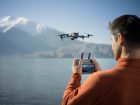
A 71-year-old Canadian man who flew a DJI Mavic 3 Pro drone over restricted military areas at Cape Canaveral has pleaded guilty to federal charges, offering new details into how an ordinary tourist used high-end consumer drone tech to breach some of America’s most secure airspace.
Xiao Guang Pan has admitted in a plea agreement that he launched his powerful drone nine separate times in early January 2025 to capture thousands of high-resolution images of Cape Canaveral Space Force Station — a site critical to US space and defense operations.
According to court documents shared by Florida Politics, Pan flew the drone from a public parking lot near Port Canaveral between January 5 and 7. Over those three days, his DJI Mavic 3 Pro — equipped with a Hasselblad camera and 28x hybrid zoom — recorded 1,919 images and videos. Of these, nearly 250 photos and videos showed sensitive military areas such as:
- Payload processing facilities
- Rocket launch pads
- Munitions storage bunkers
- A wharf for submarines
- Security checkpoints
- Mission control centers
Many of these locations are considered “vital to national defense” under US law, and photographing them without permission violates Title 18, Section 795 of the US Code.
Pan’s tool of choice, the DJI Mavic 3 Pro, is one of the most advanced consumer drones on the market. Its 4/3-inch Hasselblad sensor, 46-minute flight time, and omnidirectional obstacle sensing make it ideal for professional imaging — and, as this case proves, potentially for espionage.
Despite DJI’s built-in geofencing meant to prevent flights in restricted zones, Pan’s drone encountered no flight restrictions. According to investigators, his phone contained screenshots of Cape Canaveral satellite imagery, suggesting he knew what he was targeting.
Shortly after this incident, on January 13, DJI announced that it was scrapping its proprietary geofencing system in favor of official Federal Aviation Administration (FAA) data across the United States. However, the drone maker was quick to point out that this development was planned months ago, and that the move mirrored similar changes the company made in Europe in 2024.
As part of the plea deal, Pan has pleaded guilty to three counts of photographing defense installations using an unmanned aircraft. Each count carries up to one year in federal prison and a $100,000 fine, though prosecutors have hinted they’ll recommend a lighter sentence.
Pan’s sentencing is scheduled for October 1, 2025, in the US District Court for the Middle District of Florida. He remains out on bond but could face deportation and a lifetime ban from re-entering the United States.
In the meantime, federal officials have emphasized this wasn’t an isolated incident. In recent months, there’s been a surge in suspicious drone activity near military installations across the country, prompting calls for tougher drone regulations and better airspace enforcement.
For drone hobbyists, this case serves as a wake-up call: flying near sensitive areas, accidentally or otherwise, can land you in serious legal trouble.
More: DJI releases Power 1000 V2, but not for US buyers
FTC: We use income earning auto affiliate links. More.




Comments